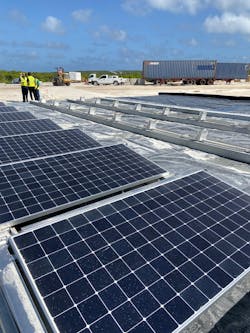A recent segment of “60 Minutes” about the Rocky Mountain Institute’s (RMI) work in the Bahamas was “incredible exposure” for the microgrid movement globally.
“We were in the living rooms of over 9 million viewers that Sunday evening. It was incredible exposure for the Bahamas energy transition, Rocky Mountain Institute and the microgrid movement globally,” said Chris Burgess, director of projects for RMI’s Islands Energy Program, who appeared in the piece.
The 60 Minutes story focused on RMI’s Ragged Island microgrid, now being built to withstand hurricane force winds in the wake of Hurricane Dorian. The hurricane battered the island and neighboring islands with 185 mph winds and gusts of about 200 mph, destroying power lines and utility infrastructure and leveling homes.
Dorian was the fifth Category 5 hurricane in the last three years. “Hurricane Alley,” a string of more than 700 low-lying islands in the region, is especially vulnerable to the hurricanes.
The microgrid, expected to be commissioned by the end of April, is part of RMI’s larger Islands Energy Program, which aims to speed the transition of island economies from their dependence on fossil fuels to clean energy and energy efficiency. Islands are especially vulnerable to the climate crisis and are pioneering ways to be resilient, RMI says.
Microgrid to provide 93% of island’s energy needs
RMI provided grant resources for the initial design, development and international procurement of the Ragged Island microgrid, in partnership with Bahamas Power and Light (BPL), which is the Bahamas’ national utility. BPL provided project funding for the project, with an aim of creating more solar and storage projects across its 21-island portfolio.
The project is a perfect pilot for BPL because the island’s power system is relatively small, said Burgess. The 390kW/1,260kWh microgrid will provide a whopping 93% of the island’s energy needs annually. That represents the highest renewable energy penetration microgrid for any public utility in the Caribbean.
Ragged Island’s diesel use will be reduced to just a few hundred hours per year. The project will cut fuel use by 52,500 gallons per year, Burgess said.
Lessons learned
Over the course of the pilot project, RMI learned that building on such a remote island — one of the most far-flung islands in the Bahamas — requires “careful planning and strategic shipping.”
In addition, Burgess and his associates found that building codes for Category 4 hurricanes were not stringent enough to withstand storms like Dorian and Irma. To address this issue, RMI employed Solar Under Storm best practices, which include using high-load PV modules, requiring structural engineering and wind tunnel reviews, calling for a bolt hardware locking system and bolt quality control process, and other recommendations.
RMI also learned about the importance of scale, said Burgess. “In subsequent procurements, BPL and RMI have decided to aggregate multiple projects into one procurement to achieve economies of scale and drive down costs further.”
Even though Ragged Island will experience important savings, aggregating this project with larger projects on other islands could yield 15%-30% more savings, he said.
Next, RMI will partner with the Government of The Bahamas and BPL to deploy microgrids in the Abaco Islands near critical facilities such as hospitals, airports, water treatment plants, water pumping facilities, schools and health centers.
“These assets will be grid tied and designed to provide renewable energy capacity and grid services at lower costs than the old diesel power plant,” he said.
The Ragged Island microgrids will be able to island and serve the critical facilities plus local areas where there are major grid disruptions.
Renewables prove more cost effective on the islands
RMI has found that renewable energy is much more cost effective than centralized diesel generation. All of the organization’s planned projects are distributed assets that displace diesel with renewable energy.
“Those distributed assets double as microgrids for segments of the grid and critical services, making them resilient infrastructure,” said Burgess.
In fact, RMI worked with BPL to deploy a solar car park canopy at the National Stadium in Nassau that can withstand the winds of a Category 5 hurricane. The car park was part of a microgrid that continued to produce electricity when Nassau lost power in 2019 during Hurricane Dorian.
“It’s a really exciting time,” said Burgess.”Renewable energy and microgrid transition (are) in full swing in the Caribbean.”
Track new about the microgrid movement. Subscribe to the free Microgrid Knowledge newsletter.








